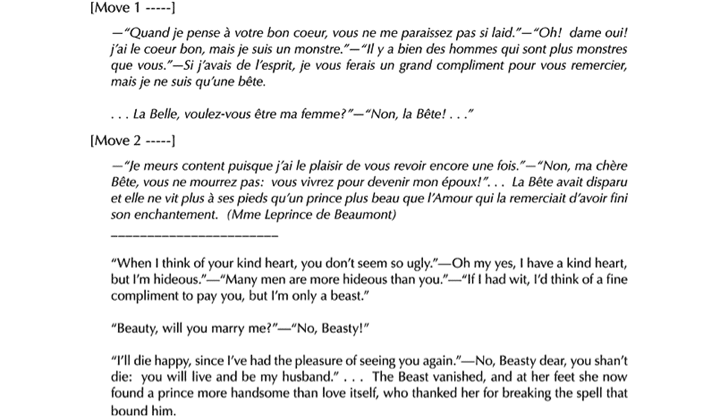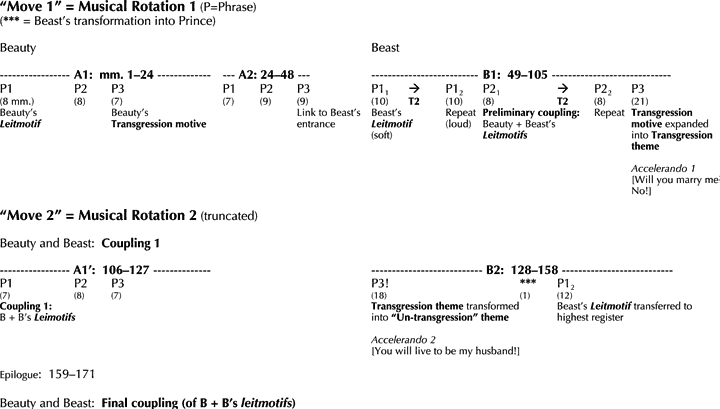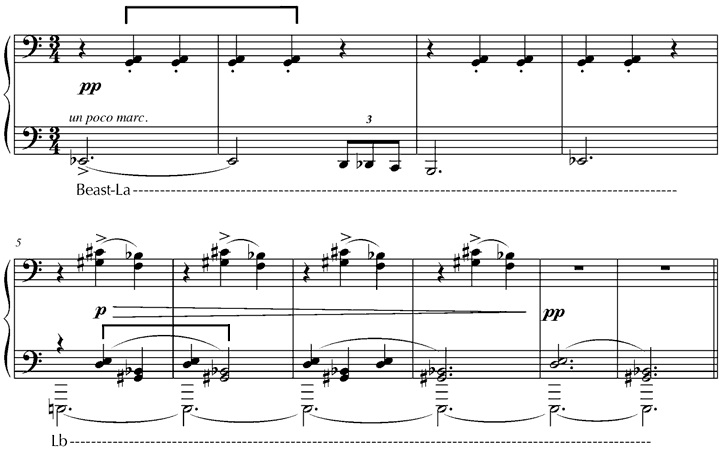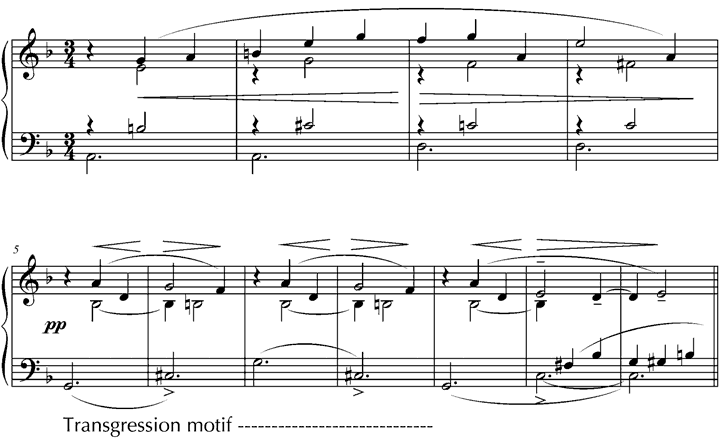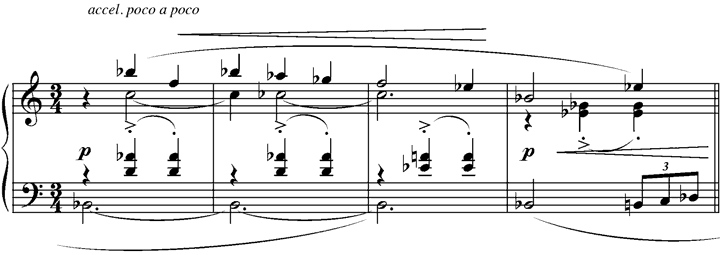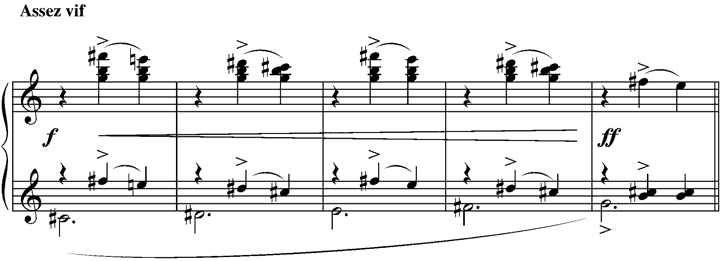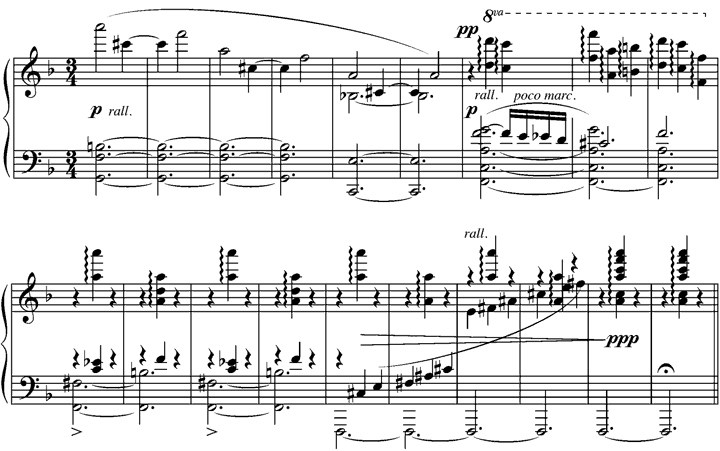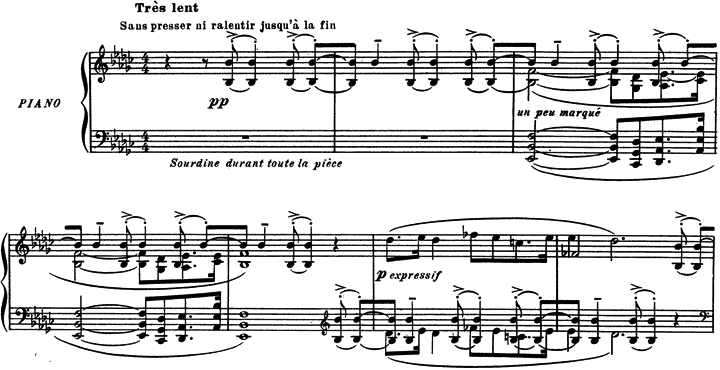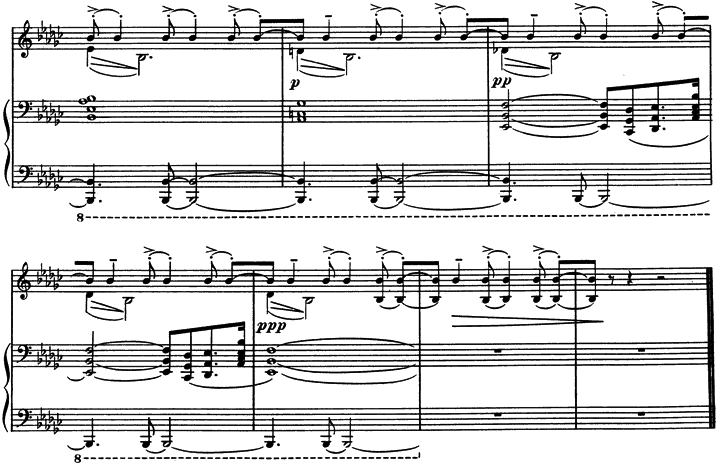Ravel’s Programmatic Impulse[1]
Peter Kaminsky
My essay addresses a central paradox inherent in the notion of program music, which may be termed the “meaning gap.” By this, I mean the potential difference in meaning or signification between, on the one hand, music’s representation of a narrative, text, title, idea, etc.; and, on the other hand, music’s ability to generate and connote its own meaning(s). As primary case study I offer “Les entretiens de la Belle et la Bête” from Ma mère l’Oye. My exploration of this movement takes as its point of departure a central analogy: that the potential gap between “external” representation and “internal” connotation may be interpreted as analogous to the gap between conscious and subconscious mentation. Such a gap is hinted at in Berlioz’s own account of the program for the Symphonie Fantastique: »The aim of the program is by no means to copy faithfully what the composer has tried to present in orchestral terms, as some people seem to think; on the contrary, it is precisely in order to fill in the gaps which the use of musical language unavoidably leaves in the development of dramatic thought, that the composer has had to avail himself of written prose to explain and justify the outline of the symphony«.While Berlioz’s statement posits one sort of gap at the heart of the program/music relationship, it becomes more relevant to Ravel’s music to consider the gap from the other direction and reverse Berlioz’s terms: thus the composer avails himself of the unique structural and expressive resources of music to connote their own meaning, in order to fill in the gaps which the limitations of the programmatic source unavoidably leave in the development of dramatic thought.
It is not my desire to make Ravel’s charming set of miniatures comprising Ma mère l’Oye, or the virtuosic triptych Gaspard de la Nuit, suffer yet another attempt to resolve the surprisingly resilient controversy over the nature and aesthetic worthiness of program music.[2] Further, I shall not attempt to contextualize Ravel’s programmatic works within some master typology, although it would be possible to do so as an outgrowth of prior research. Instead I shall focus on one small but significant point. This point concerns one of several paradoxes inherent in the notion of program music, which may be termed the “meaning gap.” By this, I mean the potential difference in meaning or signification between, on the one hand, music’s representation of a narrative, text, title, idea, etc.; and, on the other hand, music’s ability to generate and connote its own meaning(s).
My essay shall explore this gap as it is manifested in the fourth movement of Ma mère l’Oye, “Les entretiens de la Belle et la Bête.” The choice of this particular movement was simple. “Beauty and the Beast” is by far the longest and most complex movement in Mère, and it has the most substantial programmatic text of the set (included in the heading of the score). At the conclusion, I shall briefly sketch how a similar approach may be productive in the analysis of “Le Gibet” from Ravel’s Gaspard de la Nuit, based on Aloysius Bertrand’s prose poem.
My exploration of these two movements takes as its point of departure a central analogy: that the potential gap between “external” representation and “internal” connotation may be interpreted as analogous to the gap between conscious and subconscious mentation. Such a gap is hinted at in Berlioz’s own account of the program for the Symphonie Fantastique:
The aim of the program is by no means to copy faithfully what the composer has tried to present in orchestral terms, as some people seem to think; on the contrary, it is precisely in order to fill in the gaps which the use of musical language unavoidably leaves in the development of dramatic thought, that the composer has had to avail himself of written prose to explain and justify the outline of the symphony… .[3]
Edward T. Cone summarizes Berlioz’s attitude as follows: “This, then, is the composer’s account of the purpose of the program: not to duplicate the music, but to fill in what the music has left unsaid.”[4] While Berlioz’s statement posits one sort of gap at the heart of the program/music relationship, it becomes more relevant to Ravel’s music to consider the gap from the other direction and reverse Berlioz’s terms: thus the composer avails himself of the unique structural and expressive resources of music to connote their own meaning, in order to fill in the gaps which the limitations of the programmatic source unavoidably leave in the development of dramatic thought.
Such a reversal is also manifest in film music. In his book Hitchcock’s Music, Jack Sullivan comments on the director’s attitude toward music, and on his favorite musical collaborator Bernard Herrmann:
… Although Hitchcock’s musical designs often depict an outer world of action and drama, providing a rhythm for his kinetic images—the sounds commonly associated with the “master of suspense”—the deepest, most original kind of Hitchcock music evokes inner turmoil and ambivalence, pitting subconscious desires and anxieties against behavior enacted on the screen.[5]
… A product of the silent era, Alfred Hitchcock distrusted words but came to trust music; it spoke a language deeper than dialogue, allowing the world of obsession and longing, his favorite subject, to have its say. Music “can tell you what people are thinking and feeling,” observed Bernard Herrmann, who worked with Hitchcock over a greater length of time than any other composer, “and that is the real function of music. The whole recognition scene of Vertigo, for example, is eight minutes of cinema without dialogue or sound effects—just music and picture. I remember Hitchcock said to me, ‘Well, music will do better than words here.’”[6]
If music is intended to evoke subconscious desires counterpointed against the overt action seen and dialogue heard on the screen, then we need not stretch too far to draw the analogy between the overt action depicted in Ravel’s textual sources—Mme. Leprince de Beaumont for “La Belle et la Bête” and Aloysius Bertrand for “Le Gibet”—and his musical counterpoint with its potential to express the subconscious undercurrents of the stories and his interpretations thereof.
* * *
The surface events of the story of Beauty and the Beast are familiar enough to require no rehearsal here. In analyzing Ravel’s musical setting, however, it is useful to examine, albeit briefly, some fundamental aspects of the story from a structuralist and psychoanalytic perspective.
Following Russian literary theorist Vladimir Propp’s methodology for the classification and analysis of folk tales, Larry DeVries offers a structuralist scheme for Beauty and the Beast; this is reproduced below.[7]
Move I
a. Initial Situation | Father–3 Sons–3 daughters |
[g] Interdiction | [Do not wish for rose.] |
d. Violation | Wish for rose. |
b. Family Member Absent | Father leaves home. |
[g] Interdiction | [Do not pick rose.] |
d. Violation | Father picks rose. |
Consequence | Beast threatens. Father promises daughter. |
[A] Lack | [Beauty lacks husband.] |
C Hero leaves | Beauty leaves home. |
K Lack Liquidated | Beast sues for marriage. |
Move II
g. Interdiction | Not to wish to go home. |
d. Violation | Wish to go home. |
g. Interdiction | Not to overstay. |
d. Violation | Overstaying. |
A Lack | Violation caused by sisters leads to lack of husband. |
K Lack Liquidated | Return to Husband. |
M Task | Revive beast. |
N Task Accomplished | Beast revived. |
T Transformation | Beast transformed. |
W Marriage | Marriage. |
DeVries divides the story into two “moves,” which are composed of a series of states— initial situation, family member absent, etc.—and actions, in particular, the sequence interdiction → violation → consequence. Hence the story divides into two parts: the first begins with the introduction of the father and his three daughters and ends with the Beast asking for Beauty’s hand in marriage, followed by her rejection of his offer; the second begins with Beauty’s wish to go home to see her father and ends with her accepting the Beast in marriage and his consequent transformation into a prince. As we shall see, both Ravel’s extracts from the story comprising “Les entretiens” (which he places at the head of the score) and his musical setting follow DeVries’s two-part division.
In his well-known study The Uses of Enchantment: The Meaning and Importance of Fairy Tales, psychoanalyst Bruno Bettelheim interprets Beauty and the Beast as a coming-of-age and sexual awakening of a young girl. Taking Freud’s Oedipus complex as his point of departure, Bettelheim focuses on the transference of a young girl’s oedipal feelings toward her father to another male figure. The latter, personified as a beast, symbolizes her initial fear of her sexual impulses, which eventually recedes as she grows toward maturity and her transference is complete. Bettelheim writes:
Thrown into a conflict between her love for her father and the Beast’s needs, Beauty deserts the beast to attend her father. But then she realizes how much she loves the Beast—a symbol of the loosening of ties to her father and transference of her love to the Beast. Only after Beauty decides to leave her father’s house to be reunited with the Beast—that is, after she has resolved her oedipal ties to her father—does sex, which before was repugnant, become beautiful.
This foreshadows by centuries the Freudian view that sex must be experienced by the child as disgusting as long as his sexual longings are attached to his parent… . But once detached from the parent and directed to a partner of a more suitable age, in normal development, sexual longings no longer seem beastly—to the contrary, they are experienced as beautiful.[8]
Regardless of one’s views on the usefulness of structuralist and Freudian takes on fairy tales in general and Beauty and the Beast in particular, they represent serious attempts to explain the underpinnings of the story. Viewed broadly, both perspectives conceive the story as entailing three characters—the father, Beauty, and Beast—in a two-part trajectory: from Beauty’s home to Beast’s castle co-extensive with the oedipal stage; and again from home to castle corresponding to her post-oedipal transference of affection from father to Beast.
In light of the above perspectives, let us turn to Ravel’s own version of the story heading the score, staged as a series of brief conversations; this is reproduced in Example 1 below.
Example 1. Ravel’s text for “Les entretiens de la Belle and de la Bête”
Structurally, the bracketed annotations show that the dialogue selected by Ravel to retain the essence of the story clearly articulates the two-part narrative noted above. Psychologically, however, a significant change occurs: the character of the father is omitted entirely. Clearly this is desirable from a musico-dramatic standpoint; one can scarcely imagine how the father could be represented musically! With respect to programmatic interpretation, this change is highly significant: inner turmoil, change of feelings, and maturation consequently become focused solely on the character of Beauty in her interaction with the Beast. In turn, Ravel configures the narrative around Beauty’s and the Beast’s leitmotifs, themes, and their transformations.
Example 2 charts the formal design for “Les entretiens.”
Example 2. Musical design for “Beauty and the Beast”
The movement divides into two large parts, wherein narrative moves 1 and 2 correspond respectively to musical rotations 1 and 2.[9] Rotation 1 also divides into two parts, signaled by the introduction of Beauty’s and the Beast’s respective leitmotifs. (These will be discussed in greater detail in subsequent examples.) Beauty’s music goes through two iterations (A1–2) of three phrases each (P1–3). The Beast’s music is structured differently, in that each phrase is sounded twice, the second time a major second higher (marked “T2” or transposition by 2 semitones) than the first. The upward transposition helps connote the Beast’s intensity and desperation in contrast to Beauty’s (apparent) placidity. Rotation 1 ends with P3 (mm. 85–105), whose acceleration in phrase rhythm (4+4+2+2+1+1…), coupled with the tempo accelerando and dynamic crescendo, raises to a climactic pitch the Beast’s futile petition for Beauty’s hand in marriage. Rotation 2 begins with a single iteration of Beauty’s music (mm. 106–127), now coupled with the Beast’s leitmotif. Thereafter a significant formal permutation takes place as a variant of P3 initiates the next section (mm. 128ff); in turn this leads to a similar acceleration and climax, followed by the glissando (m. 146) marking the Beast’s transformation. Thereafter his leitmotif is transferred to the highest range of the piano, followed by the epilogue appropriately sounding the final coupling of the lovers’ leitmotifs.
Example 3 presents their leitmotifs as they are first introduced. The contrasts between them are obvious: Beauty’s pitch collection is the F-major scale (with Lydian inflections), while the Beast moves from whole tone (mm. 49–52) to octatonic (53–58); Beauty “sings” in approximately alto range in a flowing waltz texture reminiscent of Satie’s Gymnopédie No. 1, while the Beast’s angular melody sounds in the bass against a marcato accompaniment, and so forth. Not surprisingly, Ravel follows late 19th-early 20th century convention in his assignment of asymmetrical diatonic tonality to the human Beauty and symmetrical atonality, with its connotations of darkness, magic and the supernatural, to the Beast.[10]
Example 3. Leitmotifs for Beauty and the Beast (Square brackets indicate Major 2nd intervals)
Example 3a. Beauty’s Leitmotif, mm. 1–8
Example 3b. Beauty's Scale: F major (Lydian)
Example 3c. Beast’s Leitmotif, mm. 49-58. Latent Desire: descending bass motion.
Example 3d. Beast’s scales
Less obvious are the latent similarities between their musical representations.[11] Formally, both Beauty’s and the Beast’s leitmotifs divide into 4 + 4 bars (the Beast’s leitmotif adds a 2-bar extension), leading from harmonic motion to stasis, thereby allowing their leitmotifs to be contrapuntally combined. With respect to intervals, both parts feature major 2nds (shown with square brackets in the example), where Beauty’s are melodic and the Beast’s are harmonic. Perhaps the most striking similarity occurs toward the end of Beauty’s first section in mm. 17–20 (Example 4). In the phrase immediately preceding, the bass motion and harmony—A7-D7 as V7/vi-V7/ii—lead one to expect a continuation G-C-F supporting a ii-V-I cadential movement. However, the substitution of C-sharp for C-natural, emphasized by both the hairpin dynamics and the accent on C-sharp, delays in dramatic fashion the expected conventional and functional conclusion. Moreover, with the sliding of the alto voice from B-flat to B-natural, the resultant chord is the French augmented 6th sonority on C-sharp. As is well known, this chord represents the only tetrachordal subset shared by the whole-tone and octatonic collections, and here the chord belongs to the specific transposition of these collections embodied by the Beast’s leitmotif.
Example 4. Beauty’s subconscious “transgression motif”
Example 4a. Beauty’s “subconscious” transgression, mm. 13–23
Example 4b. Expected bass line and harmony vs. Actual bass line and harmony
How are we to interpret Beauty’s gesture in its marked departure from diatonic F-major tonality and the association of her chord with the Beast’s whole-tone and octatonic collections? I suggest that both gesture and chord present our first glimpse into Beauty’s subconscious: their latent association with the scalar context of the Beast’s leitmotif may be understood as isomorphic to her latent desire for union with him, notwithstanding her words to the contrary; hence the name “transgression motif.”
These three musical segments—Beauty’s and the Beast’s respective leitmotifs together with her transgression motif—provide the basis for all the musical material for the movement. Musically, their contrapuntal combination, order of presentation and transformation articulate the small- and large-scale formal design. Programmatically, their progression tells a story that simultaneously represents, deepens and subverts the written narrative.
Example 5 traces the trajectory of the lovers’ interaction through six stages labeled a–f, beginning with the preliminary coupling of their leitmotifs at mm. 69ff (section B1, phrase P21; cf. Example 2).
Example 5. Narrative/thematic transformations of Beauty’s and Beast’s music
Example 5a. Preliminary Coupling: Beauty’s and Beast’s Leitmotifs, mm. 69–76. Top: Beauty’s Leitmotif. Middle: Beast’s pleadings (transformed from his original “Lb”—note the similarity to the opening of Beauty’s Leitmotif). Bottom: Beast’s Leitmotif (Overt Desire: ascending bass motion)
Example 5b1. Beauty’s subconscious “transgression motif” expanded to become a “transgression theme” (mm. 85–88ff). Note intervallic progression of theme: 4ths on the outside, steps on the inside.
Example 5b2. Beast’s plea, the C#-G dim 5th, and Beauty’s transgression (mm. 97–101)
Example 5c. Beauty’s “transgression motif” coupled with the Beast’s overt desire (upward motion) (mm. 121–127)
Example 5d. Beauty’s “transgression theme” (cf. mm. 85–88ff) transformed into her “un-transgression theme” (128–131ff). Note reversed intervallic progression of theme: steps on the outside, 4th on the inside. (cf. Beauty’s original leitmotif)
Example 5e. End of Beast’s Transformation into the Handsome Prince (1st 6 measures, mm. 153–8) followed by f. Final Coupling of Beauty’s and Beast’s Leitmotifs (mm. 159–end). Note the accented F-natural/F-sharp at the beginning of the second system, marking the end of the first part of the Beast’s Leitmotif; and, immediately thereafter, the heavy emphasis on F-sharp via arpeggiation of its dominant seventh.
Stage (a) immediately follows the first two statements of the Beast’s leitmotif. Each voice in the texture transforms the respective leitmotifs: the top voice alters the start of Beauty’s theme from major second D-C to minor second D-C# in the tonal context of B major/minor implied by its dominant F#; the middle voice transforms the Beast’s original oscillating major seconds (mm. 53ff) into beseeching thirds descending a major second, suggestive of Beauty’s own leitmotif; the bottom voice inverts the Beast’s original descending triplet eighth notes, their upward direction and crescendo making overt the intensification of his desire for Beauty. Stage (b1) leads off with Beauty’s transgression gesture, now expanded from two-bar motive to four-bar theme; on a larger scale, mm. 85–8 compress the two previous eight-bar phrases as part of a process of acceleration and liquidation beginning with the Beast’s entrance at m. 49. Intervallically, the theme is characterized by perfect fourths beginning and ending the phrase and stepwise motion in between; this arrangement becomes even clearer with the acceleration in phrase rhythm at mm. 93–96 (not shown in the example). Thereafter, the section leads to the first climax of the piece (b2) as the Beast’s bass line traverses the diminished fifth C#-G (mm. 97–101), the inversion of the bass G-C# accompanying Beauty’s initial transgression in mm. 17–20. By revisiting the “site” of her transgression at the precise moment of her rejection of the Beast’s plea, the music unmistakably connotes her inner turmoil: by failing to submit to the Beast’s overt desire (accentuated by the rising triplets mm. 92–96), she stifles her own latent and transgressive desire.
Stage (c) begins with the first coupling of the lovers’ leitmotifs initiating the second musical rotation (mm. 106ff). The example shows the third phrase (mm. 121–7), in which Beauty’s transgression motif at its original pitch level is underpinned by the Beast’s sequential rising line in triplets, its swelling urgency literally representing his desire (and, perhaps, his recognition of Beauty’s own desire to transgress). Not coincidentally, the first two statements of the Beast’s sequence begin on low G and C#, elaborating the original bass succession of Beauty’s transgression in mm. 17–20. Stage (d), mm. 128ff, is signaled by the varied restatement of P3 from the previous musical rotation (cf. mm. 85ff). While the surface rhythm as well as the acceleration of the phrase rhythm and tempo are replicated unchanged, the theme itself is strikingly altered: now the major seconds frame the theme, while the fourths are placed inside; once again this is emphasized as the passage accelerates (mm. 136–9: treble A-G-D-C# || C-Bb-F-E). By permuting the intervallic succession in this way, at m. 128 the phrase begins with quarter rest-D5-C5, unmistakably recalling Beauty’s initial leitmotif opening the piece.
The foregoing chain of transformations of Beauty’s theme may be summarized as follows:
Music: | initial leitmotif → | transgression motif → | transgression theme → expands motif | transgression theme in intervallic permutation |
| m. 1 | 17 | 85 | 128 |
quality: | childlike innocence | latent sexual desire | desire increases | desire is no longer perceived as transgressive |
Thus Ravel’s music traces a progression from leitmotif to transgression motif to transgression theme to, crucially, the permutation of the transgression theme—or, if you will, “transgression squared.” But, like other musical techniques that articulate squarings, e.g., tritone-tritone, melodic inversion-melodic inversion, and so forth, one ends up where one began. Consequently, the developmental chain leads to Beauty’s subconscious transgression and its progressive intensification, which then comes full circle to where it is no longer transgressive but instead conveys her emotional readiness to accept the Beast. This progression is literally present neither in Leprince de Beaumont’s narrative nor in Ravel’s extracts from it. Rather, Ravel’s music suggests the inner recesses of Beauty’s subconscious, not by literal representation, but rather by the interaction and transformation of elements within Beauty’s and Beast’s mimetic leitmotifs.
Stages (e) and (f) similarly represent the outer trappings of the story while simultaneously interrogating its most notable event: the Beast’s transformation into a prince. At mm. 146ff, his actual transformation (not shown in the example) is suggested by means of register, harmony and tonality. Following the “magical” glissando, in (e) his leitmotif is transferred to the highest possible register, shedding all signs of bass-register beastliness. The example begins at m. 153: against the harmonic progression G7-C7 (V7/V-V7 in the tonic F major), the melody twice sounds the augmented triad A-C#-F, followed by its truncation to A-C#-A. Considering melody and harmony together, the Beast/prince is represented by a whole-tone dominant (G7#11) followed by an octatonic dominant (C713/b9). In this sense the scalar associations of his beastliness recede into the background in submission to Beauty’s tonic key: the Beast is tamed by the stronger force of conventional tonality and its representative cadential progression II-V-I.[12]
Thereafter Beauty’s leitmotif combines with the Beast’s (stage (f)), now sounding in the middle voice underpinned by the stable tonic fifth F/C. Formally this final contrapuntal combination initiates the epilogue, from which point on, as the story tells us, they live happily ever after. But the music suggests that all is not as it appears. For, although the musical connotation of subconscious mentation has focused on Beauty’s thematic transformations, the Beast’s leitmotif—or more precisely, its essential first four measures—never undergoes transformation. Consequently, he sings the same Beast song we have heard throughout, its outline F-C#-F-F#. While the example reproduces the accent at m. 162 as it appears in the solo piano transcription, in the original version for one piano four hands Ravel places an accent directly on the Beast’s F-sharp (pounded by the right-hand thumb), highlighting its clash with Beauty’s F a minor ninth below. This has further consequences: the Beast continues by oscillating between F#o7 and Bø7 chords, thereby imperiling the tonal control of tonic F major. In fact, the whole collection comprises all but one pitch of the octatonic collection on F-F# as partitioned below:
Hence the Beast’s leitmotif is not only untransformed, but his associated “supernatural” octatonic collection vies for supremacy with Beauty’s human tonality, both supported by F as pitch center. Finally, the penultimate gesture has the Beast parodying his own ascending white-note “transformation-glissando,” as his dissonating F# expands to an arpeggiated F#7 that all but obliterates Beauty’s feeble attempt to hold on to F major as tonic via her octave A’s. In short, contrary to the story—and contrary to our above interpretation of the penultimate stage (e)—musically Ravel’s Beast remains a Beast, his transformation all but nullified by his leitmotivic F# and the continuing force of his octatonicism.
But is Ravel’s musical setting truly contrary to the story? After all, Beauty accepts the Beast’s offer of marriage with no expectation of transformation, which therefore carries symbolic significance but is essentially superfluous to the “structural” action of the story. Indeed, director Jean Cocteau in his famous film version of 1946 plays throughout with the sort of reversals and ironies pursued here, including Beauty’s closing revelation “I was the monster, my Beast.”[13] With respect to Ravel’s oeuvre, “Les entretiens de la Belle et de la Bête” stands out among his early works that deal with the subject of love in its psychological as well as musical acuity and interest. The manner of its setting, in particular its illumination of the depths and complexities of the subconscious in a highly stylized manner, sets the stage for its exploration in very different ways in Daphnis et Chloé, the setting of Mallarmé’s “Placet futile,” the first two of the Don Quichotte à Dulcinée songs, and, most notably, the opera L’Enfant et les sortilèges.
In turning briefly to “Le Gibet,” we encounter a completely different species of source text, and consequently a different sort of relationship between text and musical setting. For Beauty and the Beast, it was necessary to make an interpretative leap from the outer events of the narrative to its subconscious underpinnings (taking into account Ravel’s own process of extraction in making his “libretto”), prior to analyzing the music and its complex relation to the story. By contrast, “Le Gibet” is itself “about” the subconscious, specifically the act of repression, which becomes enacted by the formal and syntactical structure of the poem. Accordingly, Ravel’s setting may be interpreted as a musical realization of the poem’s enactment of repression.
Bertrand’s poem and translation are given below.
“Le Gibet”
Que vois-je remuer autour de ce Gibet?
FAUST
Ah! ce que j’entends, serait-ce la bise nocturne qui glapit,
ou le pendu qui pousse un soupir sur la fourche patibulaire?
Serait-ce quelque grillon qui chante tapi dans la
mousse et le lierre sterile dont par pitié se chausse le bois?
Serait-ce quelque mouche en chasse sonnant du cor
autour de ces oreilles sourdes à la fanfare des hallali?
Serait-ce quelque escarbot qui cueille en son vol
inégal un cheveu sanglant à son crâne chauve?
Ou bien serait-ce quelque araignée qui brode une demi-
aune de mousseline pour cravate à ce col étranglé?
C’est la cloche qui tinte aux murs d’une ville, sous
L’horizon, et la carcasse d’un pendu que rougit le soleil
couchant.
What is it I see stirring around that Gibbet?[14]
FAUST
Ah! What do I hear? Is it the night wind howling, or
the hanged man sighing on the gibbet?
Might it be a cricket singing, hidden in the moss and
the sterile ivy with which the wood covers itself out of pity?
Might it be a fly hunting and sounding its horn around
those ears that are deaf to the slaughterer’s triumph?
Might it be a cockchafer plucking, in its halting
flight, a bloody hair from its bald pate?
Or might it be a spider, weaving a length of muslin as
a scarf for that strangled neck?
It is the bell that sounds from the walls of a town
beyond the horizon, and the corpse of a hanged man that
glows red in the setting sun.
The epigraph from Faust, “What is it I see stirring around that Gibbet?” would appear to stage the stage for the poem. But then the sense abruptly shifts, as the poem proper begins “Ah! What do I hear?” The sensate shift suggests that the act of seeing, of immediately verifying what is swinging from the gallows, is being repressed. This hint of repression then is made explicit in the course of the first verse by none other than the word “or”: “Is it the night wind howling, or the hanged man sighing on the gibbet?” We know—and the poem’s protagonist knows, at least subconsciously—that the answer can only involve the latter. But the succeeding verses repress this knowledge in favor of an insect’s or spider’s call and progressively more grisly imaginings associated with it (sterile ivy, slaughterer’s triumph, bloody hair, and strangled neck). Syntactically, verses two through five each begin with the conditional interrogative “Serait-ce”—Might it be? In the final verse, the return to the present indicative “C’est”—It is—signals the break in the pattern of repression. Formally, it loops back not only to the question of verse one, but also to the epigraph preceding, and hence to the initial site of repression: the protagonist hears the bell tolling and sees the hanged man rotting.[15]
I propose that Ravel’s “Le Gibet” enacts the repression at the heart of Bertrand’s poem by mapping two of its central structural elements into musical terms: the conditional as an initial state of tonal ambiguity which is resolved in the final section of the piece; and the corresponding loop of closing verse back to beginning as the culmination of the music’s formal strategy and the means of structural closure. This interpretation suggests Ravel’s music as a dramatic staging of the poem that places the listener in the role of the protagonist. Accordingly, the opening may be construed as follows:
Protagonist: Ah! What do I hear?
Listener, mm. 1–2: What is the structural status of the ostinato octave Bb3/Bb4 stated in isorhythm, and what does it represent?
Protagonist: Is it the night wind howling, or the hanged man sighing on the gibbet?
Listener, mm. 3–7: Is the “true” tonal allegiance of octave Bb to tonal center Eb minor, as indicated by the key signature and the prolonged opening chord in which Bb sounds as the upper fifth of bass Eb2? Or is its allegiance to pitch center Bb, by the sheer force of the ostinato, by the presence of its own reinforcing 5th (F) in the opening chord, and by the forceful turn to Bb minor in mm. 6–7?
Example 6. Opening of “Le Gibet”
Following from this musico-dramatic opening, the remainder of the movement unfolds a series of formal stages that represent in musical terms the process of willful illusion on the part of the protagonist. Example 7 presents a formal overview. The six stages, labeled S1–S6, unfold a series of five themes that lead from said initial state of tonal ambiguity (S1), to attempted tonal clarification (S2), to the climax of repression of truth (S3); the latter is signaled by the parodistic cadence in the distant key of C# and the ensuing emigration from tonal space into octatonic space beginning m. 26, marking the exact midpoint of the piece (Example 8).[16] Following the octatonic recitative (S4; in m. 29, A-natural is not part of the collection), the form doubles back on itself, as previous themes return transposed and transformed. Thus in Example 7 the arrows pointing from right-to-left signify the renewed attempt at tonal clarification. This results in the concluding Stage 6 (mm. 40–end), in which themes 4, 2 and 1 are restated over the addition of the bass pedal point on octave Bb0/Bb1 (Example 9). Under the foregoing interpretation, the return to the opening theme at m. 48, now registrally enclosed within the isorhythmic bass and soprano pedals on Bb, ends the process of illusion and shatters the protagonist’s repression of the truth by answering the initial question of pitch centricity: it is Bb, whose “victory” is as implacable as the obsessive refrain “Nevermore” from the beak of Poe’s Raven.
Example 7. Formal overview, “Le Gibet”
Example 8. Cadence to C# and octatonic space, mm. 26ff
Example 9. Structural closure and shattered repression
In conclusion, we may recall what Ravel’s friend the author and critic M.-D. Calvocoressi had to say about program music. Writing in 1908 around the time of the composition of both Ma mère l’Oye and Gaspard de la Nuit, Calvocoressi begins his essay as follows:
From the moment musicians began writing program music, descriptive or representative, theoreticians have applied themselves to clear up the aesthetic problems raised by this music. And a number of solutions have been presented which are more or less radical, favorable or unfavorable to its novel tendency, but all of which gravitate to settling the following question: can music describe and represent, is program music legitimate, is it artistic, is it or is it not inferior to pure [absolute] music, [i.e.,], to “that which pretends to represent nothing other than that which it is in itself and for itself.”
Thus posed, the problem shall always bring up renewed discussion, which will never be closed as long as one believes in the point of view of a normative aesthetic. [translation by the author][17]
Rather than debating what music can or must do in terms of a priori principles, Calvocoressi sensibly advocates an unencumbered empirical approach by observing what program music does and how it does it.
I have attempted to follow such an approach by exploring the gap between the written text and the potential for music to connote its own meaning, in order to probe subconscious motivation in the narrative and the manner of its musical representation. In both “Les entretiens de la Belle et de la Bête” and “Le Gibet,” Ravel uses relatively simple musical means to convey complex meanings. Central to “Les entretiens” is the dichotomy between two conventional nineteenth-century musical techniques: thematic transformation, associated with the transformation of Beauty’s feelings toward the Beast; and leitmotif technique, associated with the implied non-transformation of the Beast into a prince, which stands at odds with the conventional ending of the story. For “Le Gibet,” Ravel employs even more elemental means: the tonal association of the pedal point with the tonic or dominant of a key, the resulting tonal ambiguity the basis for his portrait of repression. In sum, his extreme economy of musical means and resultant complexity of dramatic effect are emblematic of Ravel’s programmatic impulse, and more broadly of his approach to musical structure.
Notes
This essay grows out of a lecture given at the Humanities Institute at the University of Connecticut, Storrs. | |
A highly abridged list of works addressing general issues in program music includes Calvocoressi 1908, Dahlhaus 1989, Hanslick 1891 (8th ed., transl. and ed. 1986), Kivy 1984, and Scruton 1997. Monographs or essays on individual works include Caballero 2004, Cone 1971, Hepokoski 1992 and 2006, and Werbeck 2003. | |
Cone 1971, 28, quoted from Berlioz’s footnote to his own programmatic leaflet for the premier of Symphonie fantastique in May 1830. | |
Ibid., 29. | |
Sullivan 2006, xv. | |
Ibid., xix. | |
DeVries 1989, 162–4. Propp includes the story as a member of a larger class of tales that includes “Cupid and Psyche,” further characterized by DeVries as entailing the notion of “Unequals in Love,” 155ff. | |
Bettelheim 1976, 307–8. | |
For an explanation of rotational form, see Hepokoski 2001. | |
Antokoletz 2004, 57 and passim; and Taruskin 1985, 103ff. | |
For an illuminating discussion of “latent unity” as a analytical desideratum, see Satyendra 2005. | |
Ravel employs a similar strategy for closure at the end of L’Enfant et les sortileges. Here the Mother’s leitmotif, a cadential progression supporting the treble descending perfect fourth B-F#, is stated as the concluding cadence in the tonic G major, the treble motive sung by the Child. By literally internalizing the Mother’s cadence in the tonic key, the Child symbolically accepts her authority. | |
Hearne 1989, 82. The notion of Beauty-as-monster is made explicit at the end of the animated film Shrek (DreamWorks Animation, 2001). | |
The English translation is by Roger Nichols (1991), who also serves as editor of the Peters edition of Gaspard. | |
In its obsessive refrain and increasingly macabre succession, Bertrand’s poem bears a strong resemblance to Edgar Allan Poe (cf. “The Telltale Heart,” “The Raven” et al), a point undoubtedly not lost on Ravel who by his own admission considered Poe his most important influence in aesthetics as well as the art of composition. See Larner 1996, 33 and passim. | |
The use of term “octatonic space” is drawn from Lerdahl 2001, 249ff. Ravel’s notation reveals another manifestation of illusion, as the ostinato Bb is renotated enharmonically as A#. | |
Calvocoressi 1908, 424. At the end of the first paragraph, Calvocoressi quotes G. Humbert, “Introduction à l’édition française des Eléments de l’Esthétique musicale de H. Riemann,” Paris 1906, p. II. |
Selected Bibliography
Antokoletz, Elliott. 2004. Musical Symbolism in the Operas of Debussy and Bartók: Trauma, Gender, and the Unfolding of the Unconscious. New York: Oxford University Press.
Bettelheim, Bruno. 1976. The Uses of Enchantment: The Meaning and Importance of Fairy Tales. New York: Knopf.
Caballero, Carlo. 2004. “Silence, Echo: A Response to ‘What the Sorcerer Said’.” 19th Century Music 28/2: 160–182.
Calvocoressi, M.-D. 1908. “Esquisse d’une esthetique de la musique à programme.” Sammelbände der Internationalen Musikgesellschaft 9/3: 424–438.
Cone, Edward T., ed. 1971. Hector Berlioz, Fantastic Symphony: An Authoritative Score. New York: Norton.
Dahlhaus, Carl. 1989. “The Idea of the Musically Absolute and the Practice of Program Music.” In The Idea of Absolute Music, translated by Roger Lustig. Chicago: University of Chicago Press.
DeVries, Larry. 1989. “Literary Beauties and Folk Beasts.” [Appendix One] In Betsy Hearne, Beauty and the Beast: Visions and Revisions of an Old Tale. Chicago: University of Chicago Press, 155–188.
Hanslick, Eduard. 1986. On the Musically Beautiful: A Contribution towards the Revision of the Aesthetics of Music, translated and edited by Geoffrey Payzant. Indianapolis: Hackett.
Hearne, Betsy. 1989. Beauty and the Beast: Visions and Revisions of an Old Tale. Chicago: University of Chicago Press.
Hepokoski, James. 1992. “Fiery-Pulsed Libertine or Domestic Hero? Strauss’s Don Juan Reinvestigated.” In Richard Strauss: New Perspectives on the Composer and his Music, edited by Brian Gilliam. Durham, NC: Duke University Press.
–––. 2006. “Framing Till Eulenspiegel.” 19th Century Music 30/1: 4–43.
–––. 2001. “Rotations, Sketches, and the Sixth Symphony.” In Sibelius Studies, edited by Veijo Murtomäki and Timothy L. Jackson. Cambridge: Cambridge University Press, 322–51.
Kivy, Peter. 1984. Sound and Semblance: Reflections on Musical Representation. Princeton, NJ: Princeton University Press.
Larner, Gerald. 1996. Maurice Ravel. London: Phaidon.
Propp, Vladimir. 1968. Morphology of the Folktale, 2nd edition revised and edited by Louis A. Wagner. Austin TX: University of Texas Press.
Ravel, Maurice. 1991. Gaspard de la Nuit. Urtext Edition by Roger Nichols. London: Peters.
–––. 1910. Ma mère l’Oye: 5 Pièces enfantines pour Piano à 4 mains. Paris: Durand.
–––. 1995. Mother Goose: 5 Children’s Pieces. Version for solo Piano by Lawrence Rosen. Milwaukee, WI: Hal Leonard.
Satyendra, Ramon. 2005. “Analyzing the Unity within Contrast: Chick Corea’s ‘Starlight’.” In Engaging Music, edited by Deborah Stein. New York: Oxford University Press, 50–64.
Scruton, Roger. 1997. The Aesthetics of Music. Oxford: Clarendon Press.
–––. ‘Programme Music’, Grove Music Online, edited by L. Macy (Accessed 28 April 2007), http://www.grovemusic.com.
Sullivan, Jack. 2006. Hitchcock’s Music. New Haven, CT: Yale University Press.
Taruskin, Richard. 1985. “Chernomor to Kashchei: Harmonic Sorcery; Or, Stravinsky’s ‘Angle’.” Journal of the American Musicological Society 38/1: 72–142.
Werbeck, Walter. 2003. “Richard Strauss’s Tone Poems.” In The Richard Strauss Companion, edited by Mark-Daniel Schmid. Westport, CT: Praeger.
Dieser Text erscheint im Open Access und ist lizenziert unter einer Creative Commons Namensnennung 4.0 International Lizenz.
This is an open access article licensed under a Creative Commons Attribution 4.0 International License.
